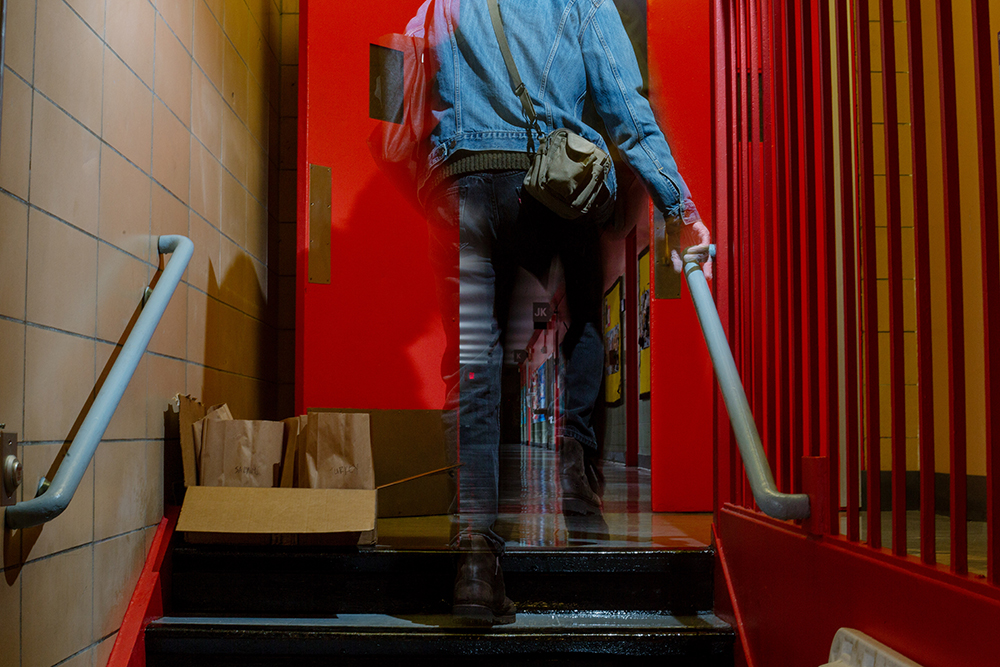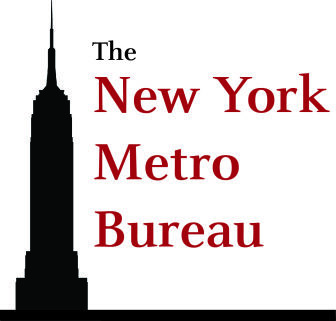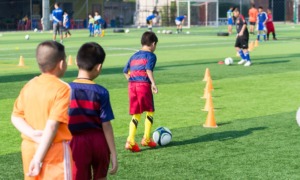
Chris Jones
St. Luke’s in Greenwich Village in Manhattan has switched its weekly arts program to a meal bag giveaway during the COVID-19 pandemic.
NEW YORK — First he lost his job as a shift manager at McDonald’s. Then the movie theater, the bowling alley, all the places he spent time in began to close. Now he has to finish his senior year of high school online, without a real graduation.
He’s yet to hear back on whether he got into his college of choice, as admissions have slowed for many institutions. Like most people in New York City, Tyler Atkinson’s life was put on hold by COVID-19; like the rest of the city he is stuck in a limbo brought on by the pandemic.
 But unlike most kids his age, Atkinson, 17, can’t quarantine inside his father’s house. He lives in a Diaspora Community Services youth shelter with over a dozen other boys and young adults. Since he can’t go to work anymore, Atkinson has a lot of time to fill, in a place where social distancing isn’t easy.
But unlike most kids his age, Atkinson, 17, can’t quarantine inside his father’s house. He lives in a Diaspora Community Services youth shelter with over a dozen other boys and young adults. Since he can’t go to work anymore, Atkinson has a lot of time to fill, in a place where social distancing isn’t easy.
“Being inside the house all the time is kind of toxic,” he said. “It’s really boring, and being bored is not good.”
For runaway and homeless youth in the city, even those who are able to stay in shelters, the “PAUSE” in daily life ordered by Gov. Andrew Cuomo can feel less like a pause and more like a staggering halt. As providers are struggling to find the resources to keep staff and the young people they serve safe from the virus, teens and young people are dealing with disappointments like losing apartment applications, getting laid off by their first real employers and losing touch with the communities they’ve built.

Sheltering Arms
Elizabeth McCarthy
A loss like that is devastating for these teens, said Elizabeth McCarthy, CEO of Sheltering Arms.
“They live stressful lives to begin with,” she said. “And through no fault of their own everything has come to a stop. These are kids who are so used to being disappointed.”
Efforts to reach Commissioner Bill Chong of the Department of Youth & Community Development and Speaker Cory Johnson of the New York City Council were unsuccessful.
Feeling stuck
There are very few beds available in youth shelters since the pandemic began. As of Monday, more than half the city’s youth shelters had no vacancies left, and there are no beds available for older youth who are 21 to 24.
McCarthy said this might be because “PAUSE” has kept many young people from transitioning out of shelters. Apartment applications have been falling through at the last minute, many job training programs have stopped, and a myriad of other things are causing teens and young people in the shelter system to fall behind on their goals, she said.
“It’s scary for these young people who were on a good trajectory for the first time,” she said. “Most everything has pretty much stopped.”
The Rapid Rehousing program run by the U.S. Department of Housing and Urban Development (HUD), which lifts many young people out of shelters, has dramatically slowed down, according to McCarthy. Jamie Powlovich, the executive director of Coalition for the Homeless, said this is mostly because of landlords not processing new leases or making necessary repairs to comply with the voucher requirements for youth to move in.
The virus has posed a problem for crisis centers, which usually can only keep people for up to 120 days. While these youth are supposed to move to transitional living facilities or more stable housing, providers have limited options for places to send them.
“There’s been a slowdown in the placement process,” said Leonor Walcott, the director of youth services for Sheltering Arms. “It’s really individual but we are anticipating that there may be some difficulties.”
Plus, New York City public schools will remain online for the rest of the school year, Mayor Bill de Blasio announced Saturday. For Atkinson, school was where he could see his friends and feel normal.
“I’m really social,” Atkinson said. “Having to stay inside, no work, school or socializing … It’s pretty draining … I’m always tired now.”
The biggest stress for Atkinson though, whose mother died in 2017, is economic insecurity. His future housing plans hinged on college. He planned to live in the dorms, wherever he was admitted. Now on-campus housing has been suspended everywhere and he doesn’t know what will be open in the fall.
Now that he’s been laid off from his job, he might be in the shelter system for much longer than he anticipated. For young people who are experiencing homelessness, staying employed is vital to the process of gaining independence from shelters.

Core Services Group
Keisha Phipps
“The ultimate goal is to exit the facility,” said Keisha Phipps, the vice president and chief administrative officer of CORE Services Group, a human services organization. “And to be able to do that you have to be employed, you have to have savings, and you really have to have sustainable income. That is now threatened.”
Many of Phipps’ clients who work in retail or restaurants are now out of a job until these businesses reopen.
“They’ve worked really hard at getting employment, in some cases getting promoted,” Phipps said. “So they’re really wondering, what does their next paycheck look like?”
And for homeless youth in New York City, applying for unemployment insurance can be tricky depending on when and how long someone has been working.
“In order to be eligible for regular unemployment insurance, you have to have a certain amount of earnings, and it’s an 18-month look back,” said Julia Rosner, an employment law specialist and attorney at Manhattan Legal Services. “If you don’t have enough earnings, you’re going to be deemed ineligible.”
This may be the case for many young workers. McCarthy said many of her clients had been working at new jobs, making it harder to receive state benefits.
“They’re feeling really stressed losing income, and losing motivation,” she said.
But young people who aren’t traditionally eligible for state unemployment are likely eligible for Pandemic Unemployment Assistance (PUA) — the federal assistance program that’s giving unemployed workers an extra $600 on top of regular weekly payments for an extra 13 weeks.
Self-employed workers, independent contractors and most people who lost their income or part of their income due to COVID-19 are also now eligible for PUA.
“Folks who were about to start a job and never got to start that job because of the pandemic are also eligible,” Rosner said. “There’s lots of ways to get in the system.”
Unemployed workers fed up with the malfunctioning system should continue to apply regardless of how many days — or weeks — it takes. The payments are retroactive to the loss of employment, meaning workers will receive pay from the day they lost their jobs.
Losing community
For young people who are separated from their families for whatever reason, building up a new sense of community and chosen family is important, said Jaysun Lukas, who was once a homeless teen and has since found housing.
“The smartest idea when you’re homeless and young is to try and stay in areas with groups,” Lukas said. “But that’s hard to do in this environment. You’re supposed to social distance and stay six feet away, and you can’t really protect one another that way.”
Atkinson said he gets along with the other boys in his shelter, but wishes he could go hang out with his friends.
“We’re allowed to go outside, but we’ve got nowhere to go,” he said. “All the places we used to hang out, the bowling alley, the movies, they’re all closed.”
Roughly under half of New York City’s homeless youth population identify as LGBTQ, according to a 2019 study by Chapin Hall at the University of Chicago. For this population, a sense of family is even more important, as many of them seek shelter because their family doesn’t accept them, said Jill Twohig, program manager of St. Luke’s Art & Acceptance, a weekly drop-in program that serves LGBTQ youth.
“Not only are our youth compromised in terms of food and shelter, but in terms of emotional support,” she said.
While providers try to fill in the gaps, Lukas said it’s still difficult to survive without the support of your peers.
“I do feel bad for the queer youth, in the fact that a sense of community is so important, even just with your friends,” Lukas said. “And right now they can’t really see their friends, not face to face, and that makes a big difference.”
McCarthy said the virus has brought some perspective to the fragmented relationships some people in Sheltering Arms have with their families.
“It’s a time where people are kind of reaching out, which is nice to see,” she said.
Atkinson can’t relate. He said he’d stay with his dad as a last resort, but he doesn’t want to. “If I’m not reaching out, there’s no reaching out,” he said.
Passing the time
For many teens like Atkinson, staying home from work doesn’t only mean a loss of income, it also means a loss of things to do.
Atkinson had only one class left to complete in high school, leaving plenty of time for him to pick up shifts at McDonald’s. Now that he’s out of a job, he’s struggling to fill his days. To pass the time, he says he’s been binging TV, playing video games and making Tik Tok videos with other residents.
“I’m definitely the positive one in the group,” he said.
Shelter providers are also faced with the challenge of filling time at their facilities. To manage the cabin fever, the staff at CORE Services Group led a workshop on how to create homemade hand sanitizer.
“They made it their own,” Phipps said. “One person had glitter in it. Another person added essential oils … so just being creative about how we can get them to forget about some of the stress that’s going on.”
Perhaps the loneliest position to be in during this time is having to be isolated inside a youth shelter, in a room away from everyone else. McCarthy said one of their clients who’s isolating in Harlem stays in contact with the other residents through Skype, but that this is not ideal for some teens.
“That’s hard for kids who in some cases have mental health issues or some kids who have abandonment,” McCarthy said. “We’re encouraging them to stay in touch with people in the house even though they can’t physically be with them.”
McCarthy said Sheltering Arms has had to isolate kids in several different shelters. Every time, they’ve been able to secure that person their own room and bathroom, moving healthy kids into rooms that can fit three people or sometimes moving them into a new shelter.
Keeping everyone safe
To keep their residents safe, shelters and transitional living facilities are making adjustments to how they run shop. Quarantining in a youth shelter with limited space can be challenging.
“We have some [clients] who still have jobs and they’re still going to work and that’s been an eternal quandary — how do we deal with social distancing,” said Rob Egan, a program director with Rising Ground, a youth transitional living facility. “It’s a new phenomenon.”
Even for those who aren’t essential workers, it’s hard to encourage young people to stay inside, program directors at several different shelters have said. The staff at Sheltering Arms facilities have started giving out small gift cards to those who don’t leave the house for five days, Walcott said.
“It can be challenging and there can be restlessness,” Walcott said. “These are young people who want to experience the world and are being denied that, so we have to find ways to work around that.”
Twohig also noticed that her clients aren’t using many protections when out in public.
“They would approach us and I would say, ‘Oh, I want to give you a hug, but I can’t give you a hug.’ We’d have to sort of stop them,” Twohig said about the youths who show up to her drop-in program for LGBTQ youth. “None of them were wearing gloves, none of them were wearing masks.”
Twohig, who regularly chats with the youth as they pick up their meals and sanitation kits, thinks this behavior comes from a mixture of misinformation about the virus and a severe lack of resources.
“I would venture a guess that it’s also just the folly of being young and feeling invincible,” she said.
Currently masks, hand sanitizer and other personal protective equipment remain difficult to get in large quantities for many essential businesses in the city. Youth homeless shelters are no exception. Egan and McCarthy both said that while they have enough protective personal equipment (PPE) for a few staff to help with cases of having to isolate sick residents, they don’t have enough masks for everyone.
For those who don’t have access to a shelter, like some of the youth who come to St. Luke’s drop-in program, staying safe is even trickier, Twohig said.
“They’re not having access to hand sanitizer, to being able to wash their hands,” she said. “So they don’t actually have the opportunity to take care of basic sanitary needs like a lot of people do.”
Atkinson says his shelter has all kinds of Lysol wipes and hand soap for when kids come in and out of the facility. And like a lot of kids his age, he’s not so scared of getting the virus. His biggest fear is that the organization he lives in could shut down at any minute or have to stop operating because of staffing issues. He would have nowhere to go.
In the meantime though, he’ll keep scrolling through Tik Tok and Facebook, happy to have a home somewhere.
As Atkinson reflects on his life in the last month, he ultimately shrugs off his own anxiety with a kind of resolve that, whether he means it to or not, sounds quite profound. “It’s like everything’s terrible, but OK at the same time.”
Niamh McDonnell contributed to this report.































